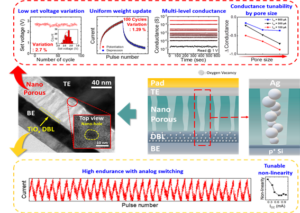Title: Reliable multilevel memristive neuromorphic devices based on amorphous matrix via quasi-1D filament confinement and buffer layer
Conference/Journal, Year: Science Advances, 2022
Author: Sang Hyun Choi, See-On Park, Seokho Seo, and Shinhyun Choi
Abstract: Conductive-bridging random access memory (CBRAM) has garnered attention as a building block of non–von Neumann architectures because of scalability and parallel processing on the crossbar array. To integrate CBRAM into the back-end-of-line (BEOL) process, amorphous switching materials have been investigated for practical usage. However, both the inherent randomness of filaments and disorders of amorphous material lead to poor reliability. In this study, a highly reliable nanoporous–defective bottom layer (NP–DBL) structure based on amorphous TiO2 is demonstrated (Ag/a-TiO2/a-TiOx/p-Si). The stoichiometries of DBL and the pore size can be manipulated to achieve the analog conductance updates and multilevel conductance by 300 states with 1.3% variation, and 10 levels, respectively. Compared with nonporous TiO2 CBRAM, endurance, retention, and uniformity can be im-proved by 106 pulses, 28 days at 85°C, and 6.7 times, respectively. These results suggest even amorphous-based systems, elaborately tuned structural variables, can help design more reliable CBRAMs.
